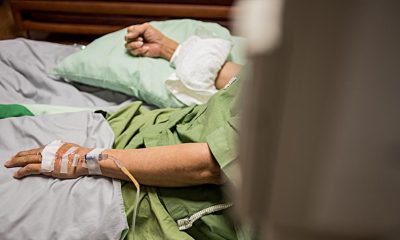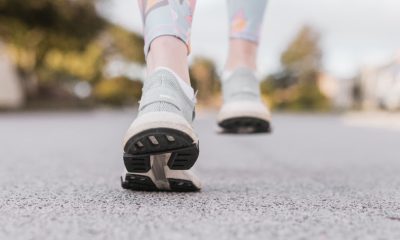Fitness
Embarrassing symptoms you should never ignore
Here are some of the most troubling symptoms that you should have checked out when you notice them.

I know that the last thing you want to do is visit your physician when you’re dealing with an ‘embarrassing’ issue like a bad smell or a problem in the trouser department, but there are some embarrassing symptoms that you really shouldn’t ignore if you want to take good care of your health.
Here are some of the most troubling symptoms that you should have checked out when you notice them.
AN UNUSUAL ODOR
If you have a hard time even saying the word ‘vagina’, visiting the doctor with an unusual odor ‘down there’ is probably the last thing you want to complicate, but an abnormal smell could mean that your vagina’s natural balance has been disturbed and that there is an overgrowth of the wrong kind of bacteria down there.
Although this is unlikely to be life-threatening, you really do need to bite the bullet and get it sorted out, because it can become very painful, itchy and even more embarrassing if you just leave it be, and there’s a slight chance that if you’re pregnant, it could cause an early birth or other issues. Once you’ve seen a professional, a dose of antibiotics, you’ll be back to your old self in a week or two.
PAINFUL BOWEL MOVEMENTS
Yes, I know, anything to do with the butt and your doctor is embarrassing, if not downright scary, but if you’re experiencing pain when you poop, you’ve noticed blood in the stool or you feel no relief after going to the toilet, it could be a sign of colorectal cancer. Of course, most of these symptoms are much more likely to be caused by hemorrhoids, fissures or any number of other minor, issues, but if it is something serious, and you leave it unchecked, you could actually put your life at threat.
When you see a doctor, they’ll do various tests to rule out cancer, and if you are found to have a problem, you’ll either need surgery, treatment or both. You can find out more about colorectal issues, including colorectal surgery recovery time here if you want to know more about the issues and why seeking treatment is nothing to worry about.
CHANGES TO THE NIPPLES
No one exactly relishes popping their nipples out for the doctor to inspect, but if you’ve noticed that the skin near your nipples has changed, your nipples are leaking, or they’ve inverted, then you need to schedule a trip to the doctor’s office.
Nipple changes could be an indication of several things, including kidney and thyroid problems, osteoporosis and breast cancer, so you really do need to have them checked out if you want to get back to good health, avoid the spread of disease, organ failure or even infertility.
LACK OF LIBIDO
Talking about your sexual problems with your doctor probably isn’t your idea of fun, but if you want to enjoy a full sex life again, and if you want to rule out serious health conditions like prostate cancer, hormonal imbalances, and depression, you’re just going to have to suck it up and make an appointment.
Whatever your problem, you can guarantee your doctor has seen it a million times before and they won’t even blink when you let it all out.
Fitness
Treatment options to help overcome knee pain for sports enthusiasts
“Sports-related pain should be evaluated quickly, especially when it’s difficult to put weight on the knee, swelling occurs or there is restricted range of motion,” said Dr. Alexander Meininger, orthopedic surgeon and MACI consultant.

Millions of people experience chronic pain, with knee pain among the most common. Athletes and active adults know the impact activities like running and skiing can have on their knees, but when chronic knee pain makes it difficult to do those activities, or even day-to-day tasks like walking up the stairs, people may often face challenges.
According to the journal “Cartilage,” unlike other tissues, cartilage does not repair itself and, without proper treatment, can worsen over time and become more difficult to treat. However, options like FDA-approved knee cartilage repair surgery MACI (autologous cultured chondrocytes on porcine collagen membrane) uses a patient’s cells to help repair cartilage defects and may help alleviate knee pain.
“Sports-related pain should be evaluated quickly, especially when it’s difficult to put weight on the knee, swelling occurs or there is restricted range of motion,” said Dr. Alexander Meininger, orthopedic surgeon and MACI consultant.
Justin Keys, a former patient of Meininger and avid skier, knows that the long-term outcomes of knee cartilage surgery can be worth the short-term sacrifices. After several injuries, including an ACL injury, Keys struggled with most activities except walking on flat, paved surfaces. After consulting with Meininger, Keys chose knee cartilage repair to help get back to his active lifestyle.
Keys considered whether to manage the injury as-is or choose MACI and undergo rehabilitation to potentially get back to his favorite activities in the future. He knew he could no longer use short-term relief methods and had to address his pain with a treatment to help provide lasting relief.
For athletes like Keys who want to fix knee pain, it’s important to consider these steps:
Discuss Options with Your Doctor
Patients should talk to their doctors and undergo an MRI to help assess the internal structures of the knee. Meininger recommends patients and their doctors discuss options for long-term knee restoration health, preserving function for future decades and recognizing the short-term sacrifice.
Set Yourself Up for Success
Experts like Meininger suggest patients take steps ahead of surgery to help their recovery.
“The important thing is to be as fit as possible and use the preseason months to undergo surgery and rehab,” Meininger said.
Patients can take steps to prep their home for recovery, which may include:
- Bringing necessities down from hard-to-reach shelves
- Moving furniture to ensure clear pathways
- Installing shower safety handles to minimize potential falls
The Road to Rehab and Recovery
Rehabilitation takes time and everyone’s experience is unique. It can be as much of a mental challenge as it is physical. Committing to a physical therapy regime, staying hydrated and eating well are important aspects to support recovery. Patients should talk to their doctors with questions and before starting any exercises.
IMPORTANT SAFETY INFORMATION
Do not use if you are allergic to antibiotics such as gentamicin or materials from cow or pig; have severe osteoarthritis of the knee, other severe inflammatory conditions, infections or inflammation in the bone joint and other surrounding tissue or blood clotting conditions; had knee surgery in the past 6 months, not including surgery for obtaining a cartilage biopsy or a surgical procedure to prepare your knee for a MACI implant; or cannot follow a rehabilitation program post-surgery.
Fitness
6 Exercise safety tips
Now, as social restrictions ease, you may find yourself stepping up your workouts, whether you’re training for an event or working to improve your game in a recreational league.

In the wake of the COVID-19 pandemic, many Americans are more aware of their health and wellness. Now, as social restrictions ease, you may find yourself stepping up your workouts, whether you’re training for an event or working to improve your game in a recreational league.
Sprains, strains and injuries can happen to even the most seasoned athletes. When you’re testing your limits, even a minor injury can alter your performance. Consider products and supports like these from the CURAD Performance Series product line, available at Walmart and Amazon, to help you get back in the game quickly and safely.
Find more resources to support your fitness journey at CURAD.com.
Keep Dirt and Germs Away
The more active you are, the harder it can be to find a bandage that stays with you all day or all game long.
Spray Away Sore Spots
Controlling mild pain can help keep you at the top of your game, and a topical analgesic works fast to heal common pain brought on by fitness and exercise, such as pain in knees, feet, shoulders and backs.
Put Pain in the Past
When recovery becomes the name of the game and pain relief is needed after daily workouts or bodily injuries. Cold packs work to heal bruises, reduce swelling and relieve headaches and general pain points while microwavable heat packs provide satisfying heat therapy to address sore and stiff joints, muscle cramps and tension.
Reduce Impact of Knee Strain
Weak, injured or arthritic knees can come from many sources, including tendonitis and a wide range of conditions that result in strain or overuse. An adjustable band can provide support for on-field sports and during workouts or everyday activities.
Manage Pain and Relieve Pressure
If you participate in endurance and strength exercises or certain sports, you may ask a lot of your joints. Kinesiology tape can be configured a multitude of ways to help reduce pain and improve blood circulation, as well as relieve tension and pressure.
Control Back Strain
When your back is strained, your body and performance can suffer. A mild or moderate sprain can benefit from strong support and compression.
Fitness
Exercise can provide relief for dry, itchy eyes
A significant increase in tear secretion and tear film stability after participating in aerobic exercise can be another remedy for relieving dry, itchy eyes.

A team led by researchers from the University of Waterloo discovered that a significant increase in tear secretion and tear film stability after participating in aerobic exercise can be another remedy for relieving dry, itchy eyes.
Every time we blink, our eyes are covered in tear film—an essential protective coating necessary for maintaining healthy ocular function. Healthy tear film comprises three layers–oil, water, and mucin–that work together to hydrate the ocular surface and protect against infection-causing irritants like dust or dirt.
When any part of the tear film becomes unstable, the ocular surface can develop dry spots, causing eye symptoms like itchiness or stinging and burning sensations.
“With so much of our activity tied to screen usage, dry eye symptoms are becoming increasingly common,” said Heinz Otchere, a PhD candidate in vision science at Waterloo. “Instead of having to use eye drops or other alternative treatments, our study aimed to determine if remaining physically active can be an effective preventative measure against dryness.”
Fifty-two participants were divided into two groups—athlete and non-athlete—to participate in an exercise session. Participants in the athlete group exercised at least five times per week, while non-athlete participants exercised no more than once per week. Researchers, which included experts from the University of Cape Coast in Ghana, performed visual examinations before and five minutes after each exercise session, where tear secretion and tear break-up time were assessed.
While participants in the athlete group showed the largest increase, Otchere says all participants experienced a meaningful boost in tear quantity and tear film stability after the exercise session.
“It can be challenging for people to regularly exercise when the demand is there to work increasingly longer hours in front of screens,” Otchere said. “However, our findings show physical activity can be really important for not just our overall well-being, but for our ocular health too.”
The study, Differential effect of maximal incremental treadmill exercise on tear secretion and tear film stability in athletes and non-athletes, was co-authored by Otchere, the University of Cape Coast’s Samuel Abokyi, Sekyere Nyamaah, and Michael Ntodie, and Ghana’s Our Lady of Grace Hospital’s Yaw Osei Akoto. It was recently published in the Experimental Eye Research journal.
-

 Product Showcase3 weeks ago
Product Showcase3 weeks agoJetstar announces direct flights to Australia from Manila and Cebu
-

 Product Showcase2 weeks ago
Product Showcase2 weeks agoPalawan Group of Companies Introduces ProtekTODO
-

 Destinations4 weeks ago
Destinations4 weeks agoRevisiting the no-entry-allowed Malabrigo Point Lighthouse
-

 Nutrition3 weeks ago
Nutrition3 weeks agoFall for flavor: The new Maple Cloud Cream Collection is here to sweeten, only at Seattle’s Best Coffee
-

 Pet Care4 weeks ago
Pet Care4 weeks agoWorld-class pet travel safety arrives in PH with Tavo
-

 Product Showcase2 weeks ago
Product Showcase2 weeks agoWhy Mega Sardines is a smart, healthy choice for every Filipino family
-

 NewsMakers3 weeks ago
NewsMakers3 weeks agoIs your health care provider really listening to you?
-

 Beauty & Fashion2 weeks ago
Beauty & Fashion2 weeks agoRenting clothes for sustainable fashion – niche markets work best

















